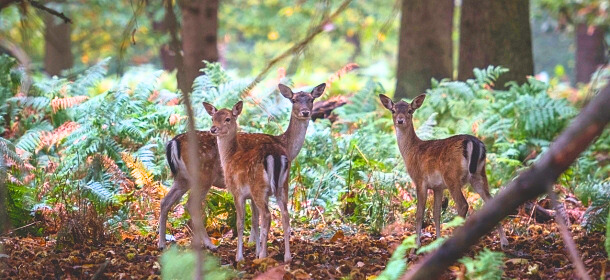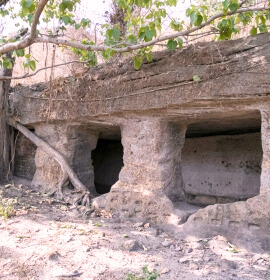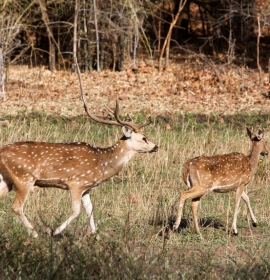About Bandhavgarh



Bandavgarh's History
The state of Rewa owes its origins to the foundation of a state dating to 1234 by Vyaghra
Dev, a descendant of the Vaghelas of Gujarat. He married the daughter of the Raja of
Ratanpur, bringing Bandhogarh (now known as Bandhavgarh) into the family as her dowry. The
legendary fortress of Bandhogarh fell into Mughal hands in 1597, almost by accident. At the
death of Maharaja Virbhadra Rao in 1593, his minor son succeeded and was sent to Delhi for
his own safety, the emperor took advantage of his absence to send one of his loyal nobles as
temporary governor. Once he had taken control of the fort, the Maharaja’s nobles and
officials were expelled and the fort annexed by the Mughals. On his return to his remaining
domains, H.H. Maharaja Vikramaditya was forced to establish a new capital at Rewa, from
whence the state took its name.
Landscape of the Bandavgarh National Park:
The "jungle" is mostly sparse and dry undergrowth with large areas of woodland. The Park is
set around the "castle" - a huge outcrop of rock with a massive plateau top. The whole area
is very dry and dusty. Covering 450 sq km, Bandhavgarh is situated in Umaria district of
Madhya Pradesh among the outlying hills of the Vindhya range. At the center of park is
Bandhavgarh hill rising 811 meters above MSL. The lowest point in the park is at Tala (440
meter above MSL). Bandhavgarh is densely populated with other species. Bandhavgarh is sided
with great cliffs and eroded rocks and on its highest point stands "Bandhavgarh fort"
estimated to be some 2,000 years old. Around the fort are numerous caves containing shrines
and ancients Sanskrit inscription.
Though small in size, yet it is the national park known for its highest tiger population.
The former hunting reserve of the royal family of Rewa; Bandhavgarh was declared a National
Park in 1968 and further extended to the adjoining Sal Forests in 1986. The thick forest and
Vindhyan Mountains surround Bandhavgarh National Park. Its plains have a number of grass and
reed covered wetlands dominated by the Kingfishers and Egrets. The Bandhavgarh National
Park, covering an area of 542.40-sq-kms, Bandhavgarh Wildlife Sanctuary has 60 resident
tigers and is noted for its tiger population. The fine trees of Sal cover half of the
Bandhavgarh National Park while the higher hills consist of the mixed forests. The wide
stretches of bamboo and grasslands cover the entire northern region. The entire national
park is encompassed by 32 wooded hills.
The Flora:
Bandhavgarh National Park is densely covered by variety of trees with Sal dominating
throughout the valley, giving way to mixed forests in the higher reaches of the hills. Mixed
vegetation like Sali, Saj, Saja, Dhobin, etc. are found in these higher lands. Stretches of
bamboo and grasslands extend to the north.
The Fauna:
The density of the big cat population at Bandhavgarh is the highest in India; and this is
the main reason why Bandhavgarh is famous among the wildlife lovers across the globe. Apart
from Tigers, Bandhavgarh is endowed with variety of wildlife species like Leopards, Gaur
(Indian Bison-although some say this is no longer seen), Chital (spotted deer), Sambar,
Dholes, Nilgais, Wild Boars, Hyenas, Chinkaras, Sloth Bears, Rhesus Macaques, Black-faced
Langurs, Jungle Cats, Porcupines, Jackals, Foxes, Wild Dogs, Chausinghas and Ratels.
The Birds:
Apart being rich in wildlife, Bandhavgarh National Park is also an abode of several species
of colorful birds, which will leave you spellbound. Major inhabitants are White-browed
Fantails, Steppe Eagles, Green Pigeons, Grey Malabar Hornbills, Black and White Malabar
Hornbills (quite a rare sighting), Blossom-headed Parakeets, Parakeets, Blue-bearded Bee
Eaters, Green Bee Eaters, White-bellied Drongos, Owls, Jerdon's and Gold-fronted Leaf Birds,
Minivets, and Woodshrikes.
Mammals & Reptiles:
There are at least 22 mammal species and about 250 bird species in the Park. The grasslands
in the park consist of chinkara (Indian gazelle), nilgai (blue bull) and chausingha
(four-horned antelope) and wild boar. The dense forests contain sambhar (Indian stag), the
muntjac (barking deer) and the herds of chital (spotted deer). Gaur (Indian bison) herds can
be seen during March and April.
In & Around Bandhavgarh:
If you are at Bandhavgarh then don’t miss to see Bandhavgarh Fort and Kalchuri
Archaeological Remains. You can also visit Khajuraho (230 km) for a complete but welcome
change. But, if you have a hunger for more wildlife then you may visit Kanha Wildlife
Sanctuary (250 km).
Climate:
Bandhavgarh experiences climatic conditions that vary to opposite extremes. In winters, the
bitter cold forces the visitors to put on multiple layers as protection against the biting
cold. Early morning rides can be in temperatures that dip about four, once you take the wind
chill factor into consideration. In the summers, it changes drastically to the opposite. It
now fee is uncomfortable to even sometimes put on the cotton t-shirt. The temperature in the
winters varies from 4 to 20°C between November and February. In the summers, the
temperatures move to the other extreme and can go up to 48 degrees centigrade. Towards late
summer, it is also advisable to carry some protection, for yourself and for your camaras,
from rain. Bandhavgarh has an average annual rainfall of 1200 mm. The rains here give very
little prior warning and it is preferable to be prepared for your own protection, as well as
for your equipment. These rains, however, bring good respite from the blistering heat. A
single shower can make temperatures fall from 45°C to 30°C.







